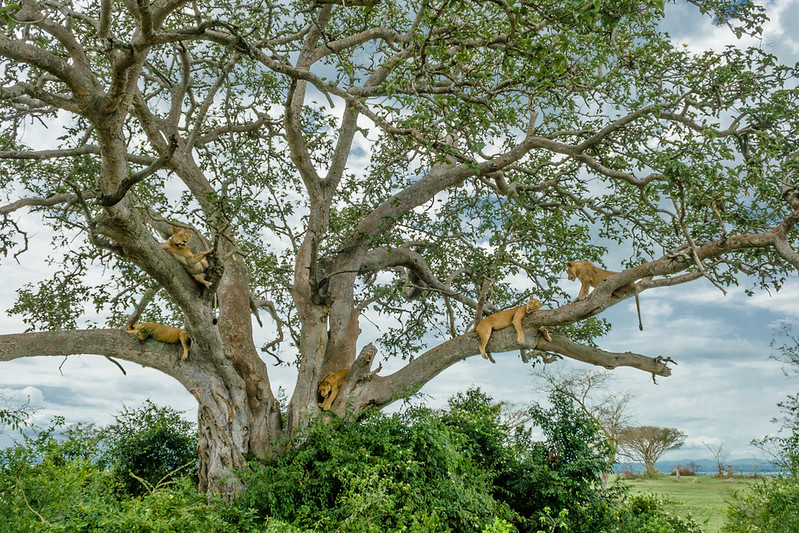
The tree climbing lions in Ishasha sector
The tree climbing lions in Ishasha sector.
The Ishasha sector, which is situated in the southern section of Queen Elizabeth National Park, Uganda’s second-largest national park, is home to the tree-climbing lions. Chimpanzees, red-tailed monkeys, black and white colobus monkeys, olive baboons, buffaloes, Uganda kobs, waterbucks, elephants, warthogs, topi, giant forest hogs, bushbucks, and more than 600 bird species can all be found at Queen Elizabeth National Park. In addition to Queen Elizabeth National Park, Tanzania’s Lake Manyara National Park is home to the well-known tree-climbing lions.
Why do lions climb trees in the Ishasha sector?
Lions in the Ishsa sector are said to climb trees for a variety of reasons, such as having a clear perspective of their surroundings for protection and a clear view of their prey, particularly during the rainy season when the grass is tall.
In the Ishsa Sector, lions scale trees to evade or flee from ground-based bug bites, including mosquitoes and tsetse flies.
Because the earth gets too hot, especially during the dry season, lions in the Ishasha area climb trees, a habit that dates back to the previous generation. They also do this to catch a cool or fresh wind.
During wildlife drives in a cozy pop-up safari truck accompanied by a qualified driving guide, the tree climbing lions in the Ishasha sector can be seen idly resting on the branches of acacia and fig trees. Other species that you will be able to see are waterbucks, elephants, topi, buffaloes, and Uganda kobs.
The best time to visit the Ishasha region to witness the tree-climbing lions
You can see the tree climbing lions in Ishasha Sector at any time of year, but the best time to see them is during the dry season, also called the peak season, which is June, July, August, September, December, January, and February. This is because the park receives less or no rainfall during this time, which results in less vegetation and a better chance to see the lions up close.
 Access roads and game drive paths in the Ishsa Sector are dry and navigable throughout the dry season, making game drives more manageable than during the rainy season when they become muddy and slick.
Access roads and game drive paths in the Ishsa Sector are dry and navigable throughout the dry season, making game drives more manageable than during the rainy season when they become muddy and slick.
How to travel to Queen Elizabeth National Park’s Ishasha Sector
The Ishasha sector is situated in the southern region of Queen Elizabeth National Park and is reachable by road transportation. It takes roughly six to seven hours to drive from Kampala to the park headquarters via Masaka, Mbarara, Bushenyi, or Kampala, Mubende, fort portal.
It takes roughly two to three hours to go to Ishasha Sector from Bwindi Impenetrable National Park, and three to four hours to drive to Kibale Forest National Park.
You can also travel to Kigali International Airport in Rwanda, pass the Katuna border in Kabale, Ntungamo, and then head to the park headquarters to reach the Ishasha area.
A scheduled or charter domestic flight from Entebbe International Airport or Kajjansi Airfield to Mweya Airstrip or Kihihi Airstrip, followed by a road connection to Ishasha Sector, can also be arranged through Aerolink Uganda or Bar Aviation.
Accommodations in the Ishasha sector
Ishasha Jungle Lodge, Enjojo Lodge, Topi Lodge, Ishasha Wilderness Camp, At The River Ishasha Lodge, Bullbush River Camp, Ishasha Ntungwe River Camp, Mweya Safari Lodge, Buffalo Safari Lodge, Elephant Hub Lodge, Park View Safari Lodge, Katara Lodge, and Engiri Game Lodge are just a few of the lodging options in the Ishasha sector where guests can spend time during the safari.
Other things Queen Elizabeth National Park has to offer
Other safari activities available to visitors to Queen Elizabeth National Park include chimpanzee trekking in Kyambura Gorge, where you can spend time with the chimpanzees; bird watching, where you can see a variety of bird species; game drive and lion tracking in Kasenyi Plains, where you can see various animals like leopards, hyenas, elephants, buffaloes, Uganda kobs, and waterbucks, among others; and guided nature walks, where you can explore the national park on foot with the assistance of an experienced park guide and an armed ranger guide.


